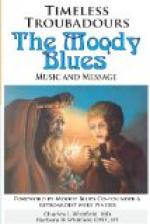borrowed it, acknowledgment was generally made.
Dante, in his
De Vulgari Eloquentia, informs
us concerning the structure of this musical setting:
it might be continuous without repetition or division;
or it might be in two parts, one repeating the other,
in which case the stanza was also divided into two
parts, the division being termed by Dante the
diesis
or
volta; of these two parts one might be subdivided
into two or even more parts, which parts, in the stanza,
corresponded both in rimes and in the arrangement
of the lines. If the first part of the stanza
was thus divisible, the parts were called
pedes,
and the musical theme or
oda of the first
pes
was repeated for the second; the rest of the stanza
was known as the
syrma or
coda, and had
a musical theme of its own. Again the first part
of the stanza might be indivisible, when it was called
the
frons, the divided parts of the second
half being the
versus; in this case the
frons
had its own musical theme, as did the first
versus,
the theme of the first
versus being repeated
for the second. Or, lastly, a stanza might [25]
consist of
pedes and
versus, one theme
being used for the first
pes and repeated for
the second and similarly with the
versus.
Thus the general principle upon which the stanza was
constructed was that of tripartition in the following
three forms:—
I
1st line }
2nd " } Pes
3rd " etc. }
1st line } 2nd " } Pes 3rd " etc.
} Diesis or Volta
1st line } Syrma 2nd " } or Coda
3rd " etc. }
II
1st line } 2nd " } Frons 3rd " etc.
} Diesis or Volta
1st line } 2nd " } Versus 3rd " etc.
}
1st line } 2nd. " } Versus 3rd " etc.
}
III
1st line }
2nd " } Pes
3rd " etc. }
1st line } 2nd " } Pes 3rd " etc.
} Diesis or Volta
1st line } 2nd " } Versus 3rd " etc.
}
1st line } 2nd. " } Versus 3rd " etc.
}
These forms were rather typical than stringently binding
as Dante himself notes (De Vulg. El.,
ii, 11); many variations were [26] possible.
The first seems to have been the most popular type.
The poem might also conclude with a half stanza or
tornada, (French envoi). Here, as
in the last couplet of the Arabic gazul, were
placed the personal allusions, and when these were
unintelligible to the audience the joglar usually
explained the poem before singing it; the explanations,
which in some cases remain prefixed to the poem, were
known as the razos.




